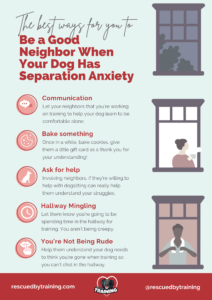Most of my separation anxiety clients live in urban environments so this is a topic I commonly deal with. If you live in an apartment perhaps the first tip-off your dog was having alone time distress was because of a nasty note slipped under your door from a neighbor. Often people have no reason to suspect their dog has separation anxiety until you get a complaint or are threatened with eviction. Apartment living can create some additional difficulties in separation anxiety training, but it’s not all doom and gloom!
The threat of eviction can put additional pressure to “fix” separation anxiety quickly and this can lead people down a dangerous path, employing things like anti-bark collars that hurt or scare dogs into not barking. But there is no quick fix for separation anxiety and dogs who vocalize when they’re distressed are communicating their severe panic and anxiety. Punishing them by using any anti-bark collar (shock, vibration or citronella) doesn’t alleviate their underlying anxiety and in fact, can make their fear and anxiety of being alone worse. The only way to permanently and effectively stop the barking or vocalizing is to address the underlying anxiety about being alone that the dog has. No panic means no vocalizing which means no need for a painful, scary anti-bark collar.
Apartment dogs often also present with watchdog barking – barking at outside noises in the hallway, people talking, dogs barking from other apartments, etc. And if you have a dog who vocalizes when they’re upset and also when they hear hallway noises, it can be hard to differentiate. Sound masking, using things TV or radio and white noise machines can be incredibly helpful to help muddle the sounds or block out external noises that might trigger the dog.
But it’s not all more complicated for dogs living in apartments. When we get to departure training, apartment dogs don’t have to learn to handle the sound of the garage door opening, the sounds of the car starting or the dog being able to see you walk away. And urban environments where apartments are most common also usually have an abundance of helpful resources, like doggy daycares, pet sitters, nearby neighbors and outdoor eateries.
Often my city-living separation anxiety dogs are more social and better behaved in public because they’ve been well socialized to a diversity of people and commonly tag along on errands with their owners, since owners are suspending absences.
I do give some extra advice to clients who live in apartments when we’re working through training. (You’ll notice a theme here.)
- Communicate with your neighbors that you’re aware your dog has alone time anxiety and are working on training to help your dog learn to be comfortable alone. This will let your neighbors know you’re being proactive and let them know your dog is struggling with an anxiety disorder. He’s not just misbehaving. Sometimes people knowing your dog is struggling with an anxiety disorder will help them be a little more empathetic to the situation. It will also let them know that you respect them and their quality of life too.
- Communicate with your neighbors that when you’re doing training, you’re going to be spending time in the hallway. You aren’t being creepy, but you need to leave your apartment for real absences frequently. You can explain this in person or slip a nice, handwritten note under their door.
- Communicate with your neighbors that when you’re in the hallway doing training, you’re not being rude when you don’t say hi or talk to them. Help them understand your dog needs to think you’re gone for training. If you’re not comfortable reaching out one to one to explain this, then I suggest having a little sign you have on hand during training so if you encounter someone in your hallway, you can hold up the note that says “Sorry – can’t talk! I’m training my dog and I need to be quiet!”
- Communicate with your neighbors and ask for help. Maybe a neighbor works at home and they’d be willing to help dog sit. Or perhaps there’s an older person who doesn’t have the ability to own their own dog but would love some companionship for a few hours. Posting a cute “Help Wanted” sign in your lobby with a picture of your dog, some basic information and when you need can help you and your dog. And maybe you’ll meet people you haven’t met before! You might even be able to barter dog sitting with neighbors also. I currently have two clients in the ame building, both doing my separation anxiety program and they help each other out! Need ideas for suspending absences? Download my free checklist 26 Ways To Suspend Absences.
- Communicate with your neighbors and be sure to thank them for their understanding and patience. Baked goods, UberEats or coffee shop gift cards as a little “thank you for your patience and understanding!” can go a long way.
As with most relationships in life, communication is the key to happiness and harmonious living. Being transparent with your neighbors about your dog’s behavioral struggles will likely help everyone feel better. And try to remember, not everyone likes to hear a dog barking, just like not everyone likes to hear babies crying. But remembering that you’re living in a shared space and respecting that is important.
 Download my latest free download: Be A Good Neighbor with my top tips for being a good neighbor when your dog has separation anxiety. Get your copy here!
Download my latest free download: Be A Good Neighbor with my top tips for being a good neighbor when your dog has separation anxiety. Get your copy here!
If you think your dog might have separation anxiety or are looking for some guidance on separation anxiety training, check out my self-paced, affordable course, Separation Anxiety Training Foundations (SATF) course.
If your dog is struggling when left alone, reach out today and schedule your assessment. Recovery from separation anxiety is possible and I can help you and your dog’s quality of life, strengthening your relationship and bringing relief to both of you. Don’t you both deserve that?
Happy training!
![]()




